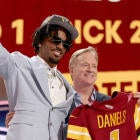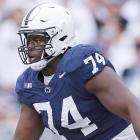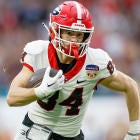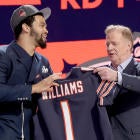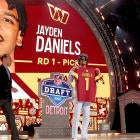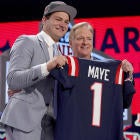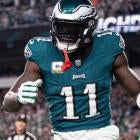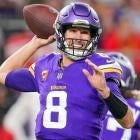
Both the Cowboys and Bills signed a receiver this week, neither of whom were Odell Beckham Jr. Imagine that.
Dallas added T.Y. Hilton and Buffalo brought in Cole Beasley. Both are 33 years old.
In the prime of their careers, they were stud wideouts. Hilton led the NFL in receiving yards in 2016. Beasley was a second-team All-Pro in 2020. But we're all wondering, what do they have left? How can they help their teams down the stretch and in the playoffs?
Let's discuss.
T.Y. Hilton, Cowboys
Because there wasn't a highly publicized release -- the Colts simply let his contract run out -- Hilton was inconspicuously available this late in the regular season. And now he'll run routes on a serious NFC contender. Patience is a virtue.
A disc issue in his neck forced Hilton to sit for the first five games of the 2021 season, and thanks to a few dings once he returned, the veteran appeared in 10 total contests for the Colts last year. He caught four of seven targets on throws made 20+ yards down the field for 169 yards and a touchdown.
Now more than a decade removed from his pro-day workout, Hilton has likely lost a step or two. But we are talking about a 4.34 speedster when he entered the league in 2012.
Check the long speed from Hilton on this admittedly ridiculous touchdown in 2021. He was open for about five seconds here before the ball was thrown. Should've been a walk-in score.
Don't let his smaller 5-foot-10, 183-pound stature fool you into thinking he's an inside wideout. He's not. Hilton ran more than 80% of his routes from an outside position in 2021. In fact, the last time Hilton ran over 50% of his routes from the slot was 2016. Given he's now a member of the Cowboys, his vast experience on the outside is critical.
For as alluring as the idea is for a dynamic wideout -- like CeeDee Lamb -- to bump into the slot because of the extra space that alignment provides, someone has to man an outside spot. In many formations, two pass catchers do.
Michael Gallup is a perimeter receiver through and through. He was at Colorado State and has been a fixture near the boundary during his Dallas career. His capability to work through press near the boundary is low-key vital. The Cowboys other outside receiver in 2022 has generally been Noah Brown. Just over 54% of his routes being run from that alignment.
While Dallas has to be content with the return they've gotten from the veteran, former seventh-round pick in an expanded role this season, there's definitely room for the Cowboys to improve at that specific, challenging position.
Ironically, the three other long passes Hilton snagged in 2021 came while he was aligned in the slot before the snap. I can't pretend to know how well Hilton can run today. But as of last year, he still had just enough juice to pose a serious threat vertically. Safeties will make it a point to locate him specifically when he's on the field with the Cowboys.
With Lamb, Gallup, Brown, Dalton Schultz, and the star running back duo, Hilton can comfortably serve as a speciality, downfield weapon for Prescott. And it's needed. Prescott only has 11 completions on throws made 20-plus yards downfield to date, the 26th-most in football.
Cole Beasley, Bills
The Bills re-signed Beasley for three reasons -- reliability, spatial awareness, and what his presence can do for the rest of Buffalo's receiver room beyond Stefon Diggs.
Among quarterbacks who've thrown at least 200 passes this season to date, Josh Allen has endured the league's third-highest drop rate of 8.6%. A bad-weather game against the Jets in Week 14 marked the third-straight game Bills pass catchers dropped four passes. For context, four drops on Allen's 27 drop backs against Gang Green equates to a drop rate of 14.8%. Woof.
From 2019 to 2021 in Buffalo, counting the playoffs, Beasley saw 339 targets. On those targets, he had only 13 drops, good for a 3.8% drop rate.
Now, some of Beasley's patented quickness has probably diminished. Although, given that he's not returning from an injury and hasn't played since early October, meaning his legs should be fresh, I'd be surprised if opposing defensive coordinators will feel comfortable leaving their nickel corners, linebackers, or safeties on Beasley one-on-one in man.
However, if they do, and Beasley's twitch isn't what it was even in 2021, he can still be a valuable asset against zone coverage. He's always had impeccable feel against zone. Beasley quickly diagnoses when to sit in a void or continue forward into open space --- whatever it takes to make himself available to his quarterback in real-time. That keen awareness doesn't rely upon athleticism or quickness.
Notice here, against the Jets in the 2021 regular-season finale, how Beasley didn't continue up the field, which would've closed the throwing window for Allen. Instead, Beasley sat down after getting off the line, caught the pass, and accelerated for the first down.
In the 2021 regular season, Beasley caught 57 of 70 targets (81.4%) against zone coverage at 8.6 yards per grab. Only Stefon Diggs had more catches (58) on the Bills but did so on 13 more targets. Beasley made just over 3.5 receptions against zone each regular-season game and was very efficient turning targets to catches.
Entering Week 15 this season, Isaiah McKenzie, who's primarily played in the Beasley underneath slot role, has 21 snags against zone coverage on 27 targets (77.7% catch rate). He's played in 12 games, meaning he's averaged 1.75 receptions against zone. That's almost exactly half the against-zone production Beasley provided Buffalo's offense in last year's regular season.
McKenzie's dropped three of those passes on 27 targets (11.1% drop rate). Beasley had three drops on 70 targets (4.2%) in the 2021 regular season.
With Beasley in the mix, presuming he'll reassume at least a sizable portion of old job responsibilities, McKenzie moves into the gadget/jet sweep role, and, in theory, secondaries won't be able to spend as much attention on Gabe Davis deep down the field.














